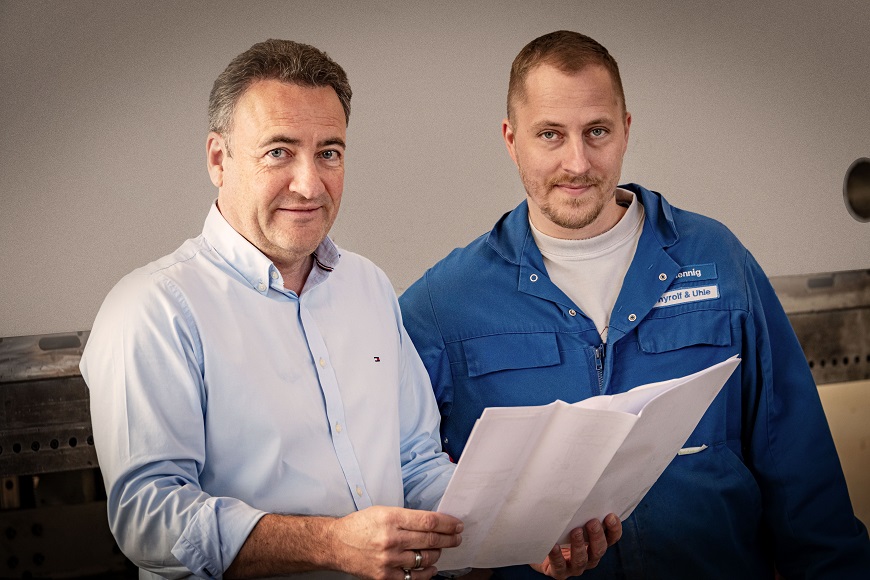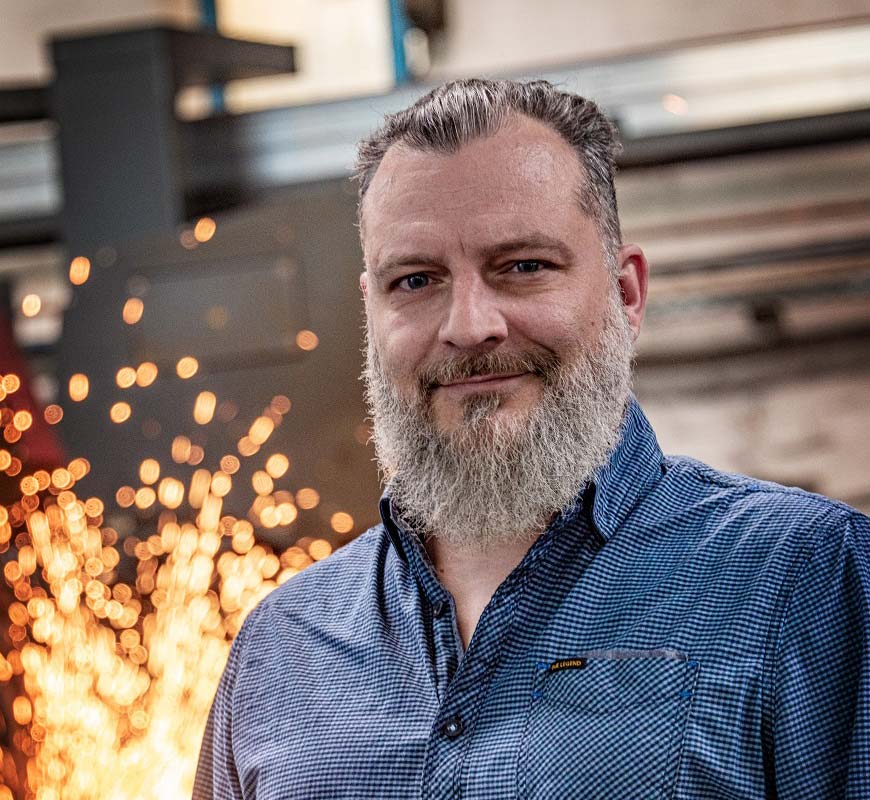
As a specialist in sheet metal and profile preparation for mechanical engineering and steel construction, Thyrolf & Uhle has established an excellent reputation. Since its inception in 1993 in the Bauhaus City of Dessau, the company has been growing constantly. A few years ago, it begun its own digitization journey with help from Lantek. We had the opportunity to interview Johannes Rieder, who runs the business with Frank Köppe, and Jan Rätzer, project manager for digitization. Here is what they have to say about their experiences with Lantek.
What brought Lantek and you together?
Rieder: We process more than 10,000 tons of steel in cutting, mechanical treatment, and steel construction every year for more than 600 customers from a wide variety of industries around the world. For this we utilize very diverse machinery including two CO2 laser cutting machines, two fiber lasers, two oxy-fuel cutting systems, and three plasma cutting machines as well as beveling, rolling, punching and nibbling technology, bending machines, welding and chamfering robots, and centers for mechanical processing. Our laser cutting machines had different programming systems which meant extensive work and little flexibility. We wanted a comprehensive solution and we came across Lantek which supplied the OEM programming software on our LVD laser. The machine-independent functionality of their software and the technical know-how of their experts were very convincing. Five years ago, we first implemented Lantek Expert and gradually integrated Lantek Integra for operations management (ERP) and Lantek MES Manager as our new production management system (MES). Now, we can program all the machines with one software package and monitor them at all times, with controlled data access according to position and authority.
What other advantages does cooperation with Lantek bring?
Rieder: Now we know, in real-time, what´s going on in the workshop, where every single part is, and the progress of every single order. Thanks to this software we have increased our speed by 30 percent, significantly lowered our scrap rate, reduced our remnant stock by 70 percent, and cut the costs of our materials management by a six-figure sum. Streamlining the processes involved in waiting or searching for stock has significantly minimized our production times.

How come?
Rätzer: Our focus has always been excellent performance, diversity of industries served, and uncompromising adherence to delivery dates. Before Lantek Integra, we used to work order-related. To this end, we used to define priorities for our orders daily which resulted in short-term, day-to-day production planning. Planning was ad hoc – as the size of the enterprise grew and the volume of orders increased, this inevitably led to longer processing times. Planning simply became inaccurate and ineffective. All these problems were left behind the day we implemented Lantek Integra. Today we can see, immediately, how the orders must be scheduled to optimize each run. The daily briefing is now no longer necessary – data and information for each order is stored in the system. Before, every order had to be discussed in the daily briefing now, this is only necessary in exceptional circumstances as our staff can consult Lantek Integra or Lantek MES Manager for order information.
How would you call your current working method?
Rätzer: Parts-related – as soon as an order is received, programming and production see nothing but individual parts which are then scheduled by the system according to their processing requirements. The programming performs a highly efficient nesting on the sheet and the respective nesting automatically receives the date of the part which has to be finished first. Each and every part makes its way through production according to its manufacturing requirements and, in the end, everything comes together in the shipping department. This is only possible with the high-performance system Lantek offers. Without it, we would be losing track instantly.
Where do the enormous savings in your materials management come from?
Rieder: We also used to buy order-related which accumulated too much material because too few of orders were pooled. As a result, it often happened that in quick succession the same sheets were ordered several times and delivered with their respective costs for logistics. Today we combine orders which yields lower logistic expenses. Cutting was elaborate and produced too many remnants because we also cut order-related. Non-cutting time for remnant logistics was just too much. The market accepted these costs for quite a while, but this has changed in recent years.
How did you change your processes?
Rätzer: First, we geometrically registered all our remnant sheets and numbered them individually. Now we seek to avoid making remnants in the first place. We know it takes three to five days for a sheet to be delivered after an order is placed. We use this time for nesting as many parts as possible on this particular sheet and most often the rest is useless scrap. Thus, materials management does not have to commission a sheet for every single new order because programming has an overview of the remnants in the system. On these virtual remnants programmers can add parts to their nesting and even fill the space between big parts with smaller ones.
As I said: because of part-related processing, programming does not care about orders at all – it only sees the individual part and the date it must be finished.
To optimize processing, Lantek Expert offers a multitude of functions like multi-torch, micro joints, distance to the edge of the sheet, common or chain cutting, and much more. One of our programmers is very enthusiastic about the chamfer function. Previously he had to enter the chamfers for each part individually, but now he does it once for one part and it is automatically adopted by all the others.
Let´s go back to the start: How do you create orders?
Rätzer: As soon as a customer places a request for quote, the respective parts are imported into Lantek Integra – this is now also possible with STEP files – where they are displayed as a clickable template. All materials and processes are stored in the system as well as cutting data, technology charts of the machines, and individual customer rates. With all this information, the system, almost instantly, automatically calculates time and costs for the quotation. It’s amazing how much the likelihood of winning an order depends on how quickly your offer is sent – today, tomorrow, or even the day after tomorrow.
What happens then?
Rätzer: Once the offer is approved it is transferred into the system as a production order and immediately appears in the production tracking of Lantek MES Manager, monitoring and controlling it, until the whole order leaves our factory from the shipping center. Thanks to the complete digitization of this process we can track every single part, even after its delivery, regarding data such as measurements, quality, value, or certification. For this, the batch number is entered into the system as soon as a metal sheet is checked into inventory which enables tracking of the complete life cycle of each part cut from it. Thus, our documentation is also completely automated, allowing us to quickly access all necessary documents from the system.
How did the parts-related way of working change your production?
Rätzer: The employees don´t have to wait anymore for a “go” from their colleague performing the previous step. All this is shown in the display. The workshop manager can view real-time data about our machines while offering an overview of their workload and production tracking via Gantt charts. We can also plan our shifts and operating hours. The concept is kept quite simple and offers a multitude of possibilities to generate reports according to individual criteria.
For our colleagues this was an enormous change because they had to alter their way of thinking and say “goodbye” to Excel-based production. However, since a fully nested sheet takes five to six hours to run through the machine, they have enough time to assign the parts to their downstream operations whether it be drilling, welding, deburring, or directly sent to the shipping department.
Do you have further plans with Lantek?
Rieder: Yes, exactly for the tasks Mr. Rätzer just mentioned. Currently we are integrating the non-cutting processes into the system to be able to streamline our workflow even more. Thanks to Lantek, we are on our way to a more digitally connected factory and this is a good thing.